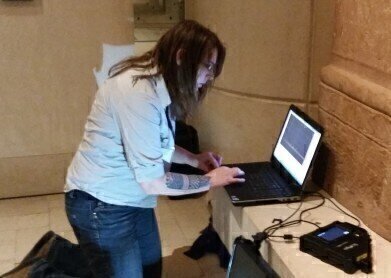Mass Spectrometry & Spectroscopy
Raman Materials Analysis Helps Researchers Understand the Use of Colour in Roman Sculpture
Dec 06 2017
Dr Louisa Campbell is researching Paints and Pigments In the Past (PPIP) in her role as Postdoctoral Fellow in Archaeology at the University of Glasgow, a project part-funded by Historic Environment Scotland's Archaeology Programme.
The project team aims to analyse and identify the compounds in pigments used on Roman sculpture, with a focus on distance stones from the Antonine Wall. Most of the examples available were discovered between the 17th and 19th centuries, and are on display at the Hunterian Museum at the University of Glasgow. The central aim of the project is to identify the pigments originally applied and then to recreate an authentic palette of colours to enable them to be digitally reconstructed.
Dr Campbell had previously used p-XRF technology for her analysis which began with sampling of a distance slab that had been repainted in 16th century and installed into a dramatic setting in Dunnottar Castle, Stonehaven. She is supporting the work with Raman technology to draw comparison between the data and to reach a better understanding of the chemical and mineral compounds which the original pigments comprised.
She has just completed a period of intensive data gathering using a SciAps Inspector Raman® handheld materials identification system on short-term loan from Analytik UK, SciAps' official distributors in the United Kingdom and Ireland. This unique instrument enables one micron Raman material discrimination which can increase the number of samples identified by eliminating unwanted samples and background fluorescence.
Patricia Weeks, World Heritage Site Coordinator for Historic Environment Scotland said: “This is a great example of an archaeological project using new technology to provide an insight into the use of colour in the Roman World. It helps us to reconstruct, and better understand, what these monuments would have looked like when they were first displayed. The results of Louisa's work will allow us to consider the wide range of colours that may once have decorate these stones, and will help to inform digital and physical reconstructions of carved stones from the Antoine Wall as part of a wider Heritage Lottery Fund bid.”
Dr Campbell expects to have developed some initial conclusions by early 2018 and will publish her findings for peer review once complete.
Digital Edition
Lab Asia 31.2 April 2024
April 2024
In This Edition Chromatography Articles - Approaches to troubleshooting an SPE method for the analysis of oligonucleotides (pt i) - High-precision liquid flow processes demand full fluidic c...
View all digital editions
Events
Apr 24 2024 Jakarta, Indonesia
Apr 25 2024 Istanbul, Turkey
Apr 28 2024 Montreal, Quebec, Canada
May 05 2024 Seville, Spain
InformEx Zone at CPhl North America
May 07 2024 Pennsylvania, PA, USA


















